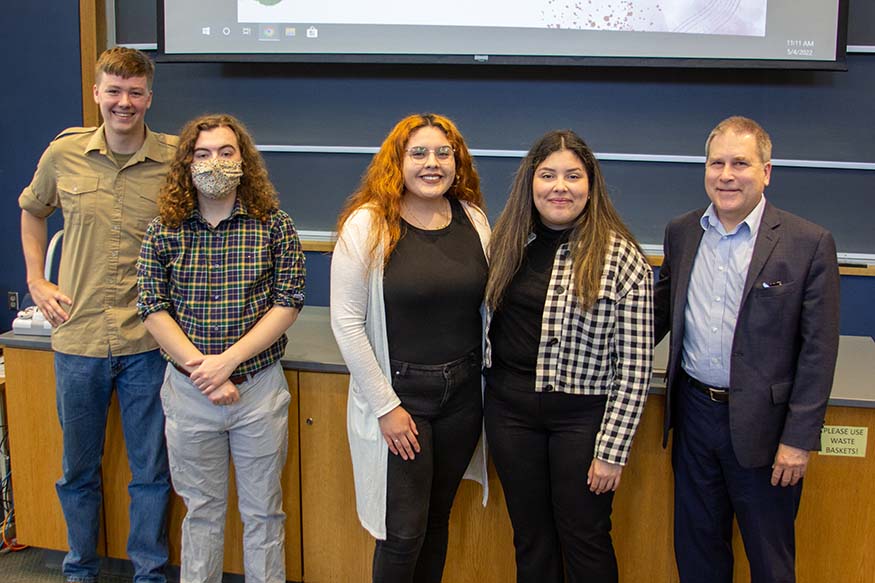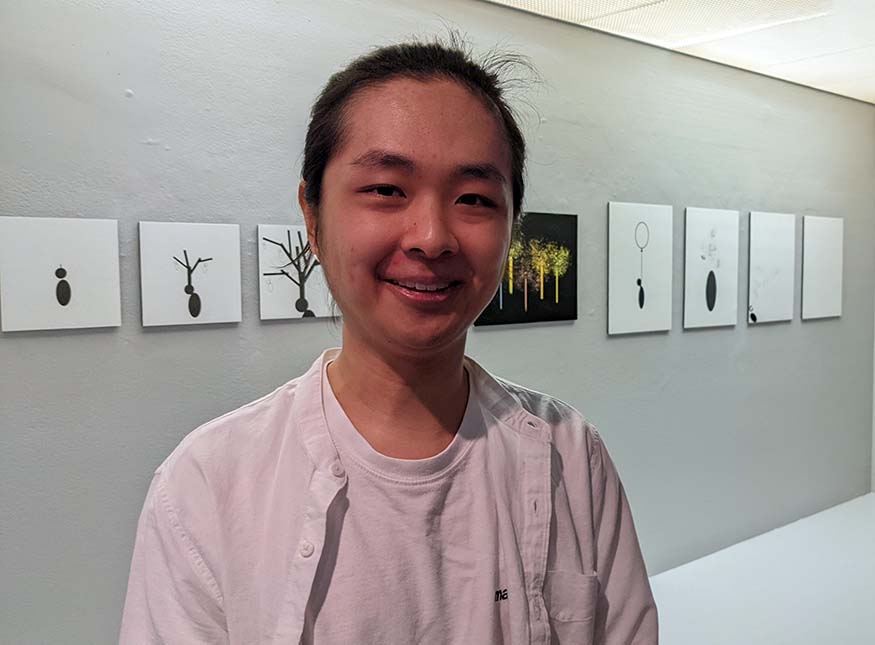Students, faculty share new knowledge in Celebration of Learning
The breadth of a liberal arts education was on full display at the 365体育投注_365体育备用网址@ 365体育投注_365体育备用网址@ Celebration of Learning, where students and faculty presented their academic work for the year.
A sample of the day's topics shows the range of interests:
The physics of drift-skating
International efforts to combat sex cybercrime
Art therapy and a "rage room"
The legacies of WWII Japanese militarism
Human-computer interaction
The ethics of emotional support animals
Naloxone education materials
The effectiveness of lasers to unblock arteries
Here are a few presentations in more detail. See the Celebration of Learning program for all listings.
Lindsey Johnson: Medical illustration at Baylor

Lindsey Johnson '22 and Scott Weldon at Baylor 365体育投注_365体育备用网址@ of Medicine
In the summer of 2021, art major Lindsey Johnson '22 found herself dressed in medical scrubs and sitting in on pre-op chats about aortic dissection. Johnson was teamed with esteemed medical illustrator Scott Weldon in Baylor 365体育投注_365体育备用网址@ of Medicine's cardiology research department during her 10-week Texas Medical Center internship.
For the first part of her experience, she studied aortic anatomy and digital illustration to prepare for her official assignment. She made the switch from hand-drawn sketches to detailed digital renderings of the entire aortic system — a new-to-her skill. Once prepared, her team assigned her a specific patient with an acute aortic dissection diagnosis.
During the rest of her internship, she followed the patient through multiple rounds of surgeries, CT scans and post-op discussions to create detailed and medically accurate renderings of their aortic dissection. Ultimately, her illustrations will be used in publications to aid in future treatments like the patient she studied.
She said the most exciting part of her Texas Medical Center experience was learning a new skill set and learning more about such a unique career path. "I was also given the opportunity to watch an open heart surgery where they replaced a patient's entire aorta with a graft," she said. "It was a once-in-a-lifetime experience."
Johnson, who comes from Rockford, Ill., also presented on her work at the Senior Art Exhibit later in the day.

History presenters, from left, Luke Melton, Liam Edmund Kelly, Fatima Dominguez, Alondra Ochoa and advisor Dr. Lendol Calder.
Luke Melton: Panzers in the East
Luke Melton, dressed in a military fatigues-style shirt, presented "Panzers in the East," a look at the German invasion of the Soviet Union in World War II. He pointed out the similarities between that invasion and the U.S. invasion of Iraq during Desert Storm and how both influenced military operations today.
Panzer is the German word for "tank." Melton went on to explain tank styles through the years in the four countries. In WWII, the Soviets had older, outdated tanks or large, hard-to-maneuver tanks. German tanks were similar to their military operation goals: speedy and stopping for nothing.
Thirty years later, Iraq was using tanks bought from the former Soviet Union, which were now even more outdated or built with armor so thin it could be penetrated by a U.S. machine gun. The United States rolled out new tanks right before Desert Storm with state-of-the-art technology — some of the best tanks in the world.
However, Melton pointed out that tank technology hasn’t changed much since the Desert Storm era, while infantry, guns, drones, etc., have evolved technologically through the years.
“Military operations today are basically old school, WWII tactics, with new-school technology while trying to combat the logistics of a modern war,” Melton said.
When asked how these tactics relate to the current war in Ukraine, Melton explained tank technology hasn’t changed and Russia is using the same tactics as in WWII while struggling with urban warfare.
Anti-tank missiles have become more advanced and effective, he said. For example, the Javelin missiles Ukraine uses go literally above the current armor of Russian’s outdated tanks to strike them at the core where there is no defense.
Melton is a senior history major from Moline, Ill.
Fatima Dominguez: The Americanization of Silvis' First Generation of Mexican Americans
Fatima Dominguez, from Poplar Grove, Ill., discussed the life and assimilation of Mexican Americans in nearby Silvis, Ill., after the Mexican Revolution.
The Mexican Revolution brought social and economic instability to the country, which forced many Mexicans to flee to the Midwest in hopes of finding work and economic stability, Dominguez said. Silvis was one of the places offering industrial and agriculture jobs, although the living conditions were less inviting. Most of the Mexicans lived in boxcars without running water, Even then, many were driven out by white townspeople in the 1920s, to live on the muddy Billygoat Hill.
Using primary sources and historical photographs from Silvis, Dominguez followed two men, Manuel Macias and John R. Cervantes, through their journey to both assimilate and bring their culture to the small town.
“I really felt a connection with the people I’ve studied,” Dominguez said. “Even though we are centuries apart, I feel the same way as they did just looking for their people and keeping up their culture.”
These men were influential in bringing more immigrants to the area in the early 1900s. Macias created a brass band that played both American songs and Mexican folk music. Cervantes was an 365体育投注_365体育备用网址@ graduate who details his stories in his book "My Moline: A Young Illegal Immigrant Dreams."
Today, Silvis pays tribute to this generation of Mexican-Americans with Hero Street, dedicated in 1968 to those military families who paid the ultimate sacrifice for their new country.
“Sometimes Mexican Americans get put in a stereotype of lazy or wanting to steal jobs, but my presentation shows exactly the opposite,” Dominguez said. “These Mexican-Americans wanted to work hard and loved their new country even if their new country didn’t love them.”
She is a senior history and political science major.
Jinsoo Park: Understanding depression

Jinsoo Park asks in his art, "What does depression look like? What does happiness look like?"
Park, a graphic design major from Seoul, South Korea, is among the students exhibiting at the annual Senior Art Exhibition.
His quest to understand depression and how it affects people led him to make art about human mental states and emotions. He used Adobe Photoshop and Illustrator to create the art, and print it, working in black-and-white and with simple shapes to avoid any specific characteristics
All the human shapes in Park's art look the same. He said he is making the point that we can't tell whether a person is depressed simply from their appearance.
"There are many reasons for making art," he said. "I usually make art so that I can express my feelings, emotions in the art and by the art. I want my art to be easy to approach, easy to understand, but I also want the audience to find more meaning by looking closer and thinking once more about it.
"I want people who suffer from depression to feel that they are not alone by my art."
Park's prints use similar elements but each is different because, as he said, depression is not just feeling sad — each piece represents the different emotions, feelings and elements of depression.
Viewers will note that Park's figures seem to be hanging themselves from balloons (usually a symbol of joy), which he said is intentional irony.

